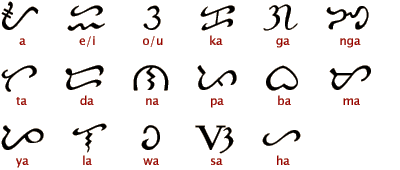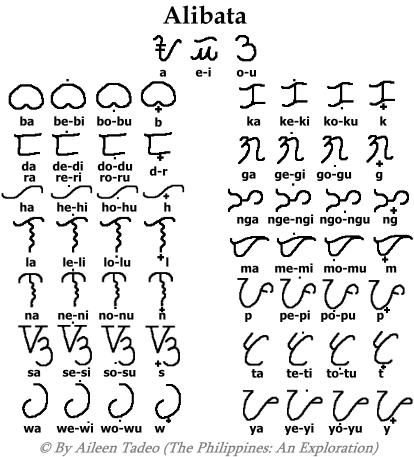Life & Culture of Filipino
The Vowel of Filipino Alphabet

Image Source
Vowels of Philippine alpabeth ar "a, e, i, o, u."
There are only 3 original vowels in the ancient Filipino alphabet and these are the reason why there are only three symbols that represents these sounds in the early alphabet and it was the basis of my opinion. The vowel a, i, u, are only needed to write the Visayan language which exactly represents the vowels of our language.
In the regions of Ilocano, Pangasinan, Pampangan, Bikol, Bisayan, and Tagbanwa, I noticed that they can clearly pronounce the vowel e and o. There's no doubt, this is due to the influence of the west which turn out to be the reason why Filipino distinguish the sound of e and o from i and u, without compromising the soung of the Philippine vowels.
Since we are talking about general orthography, we need to utilize all of these like as important to embodied the sounds that were used in our primary language. This the reason of these study of the five vowels that can be heard in all the language continents, for the Filipino orthography. It is a development to improve our sounds and even its a preparation to borrow foreign languages to foster our own vocabulary, the levels of different sounds which is deeply rooted in Filipino languages.

Image Source
The sound of the vowel "a" is like the Spanish word "mar," which is arm in English, "aga" (morning, early) in Tagalog and Bisaya; the "e" should sound like the word "este" in Spanish, "they" in English, and "bage" (thing) in Pampangan; "i" should be sound like "mill" in Spanish, "fill" in English, "bini" (kind-ness, modesty, respect) in Bikol; "o" on the other side should sound like "moro" in Spanish, "long" in English, "noo" (forehead) in Tagalog; "u" should sound like the word "tuyo" in Spanish, "full" (puno) in English, "aguy" (alas!) in Bisaya. I believe that these are the sound of the Filipino vowels.
The high and low sounds of the Filipino vowels, even the temporary guttural sound which is referred by the early writers of Tagalog which is "penultima correpta pausal" and penultima correpta guttural" depends on condition, which were also identified by Dr. Saleeby that sounds like "hamzat" in Arab and "aleph" in phoenician, which is just right to be embodied in the symbols of diacritic in our writings.
We don't need to consider every level of tone or the process of expressing it as separate vowel like what we noticed in the Sanskrit, because that kind of arrangement will only cause confusion. The "i" and "u" vowels should be use at the start or in the middle of a word instead of "e" and "o"; while "e" and "o" is appropriate on the last part of a word.

Image Source
In our oral languages, it is not necessary to distinguish "e" to "i", and the "o" to "u" to avoid confusion. There are lots of Filipino nowadays that uses "e" and "o," but just to replace "i" and "u," it's not because the sound of the word has changed, but because of the truth which showed their broad utilization of the vowel "i" and "u."
There are no basis in the foundation of our language that states when to use "e" and "o," and when to use "i" and "u," except on the compromised beauty of expression. The stated rule which were proposed above are just base on facilitating ease of pronunciation.
As a general proposition, I believe that we can properly follow these rules in our vowels, since we knew that they have the same origin. Lakta presented his reason about this: we can noticed that "e" and "o" are always followed by "i" and "u" in the natural arrangement of pronunciation.It is certain that the tendency of mouth opening is at the last part. So, I will write the Tagalog "parine ka" (come here) instead of "panini la"; and the Bisaya "kabubut'on (will) instead of "kabubut'un.

Image Source
Source:
Buhay at Kulturang Filipino
By: Norberto Romualdez
interesting
Downvoting a post can decrease pending rewards and make it less visible. Common reasons:
Submit
Yeah right. Im a Filipino but this were not thought to us during my time. Yes vowels and consonants are there but I think it was not deeply thought.
Downvoting a post can decrease pending rewards and make it less visible. Common reasons:
Submit